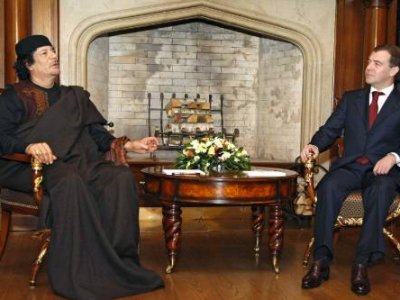
Moscow Responds to the Arab Revolutions: Focus on Libya (Part One)
Publication: Eurasia Daily Monitor Volume: 8 Issue: 79
By:

Each recent decade has witnessed its own tectonic shifts that recast the world. Commentators called them revolutions. In the late 1980’s it was the “Velvet Revolution,” which began in Eastern Europe, included the disintegration of the Soviet Union, and ended with the multiple civil wars that tore Tito’s Yugoslavia apart. On the whole, that revolution in its many manifestations was relatively peaceful, involved minimal external intervention, and its worst cases justified humanitarian intervention to limit the bloodshed. In the post-Soviet space it left behind a legacy of “frozen conflicts” which can, as events in Georgia demonstrated in August 2008, lead to local wars and international complications. In the last decade “color revolutions” overthrew corrupt, authoritarian regimes and were intended to result in the triumph of civil society and political democracy but turned out to be something less than advertised. Now the world watches “the Arab Revolution,” which began in Tunisia, spread to Egypt and grips much of the Arab world and in its latest manifestation has turned Libya into a battleground and civil war. Moscow, of course, has its own perspective on these revolutions. While coming to terms with the Velvet Revolutions in Central Europe, the Russian elite remains deeply divided over the breakup of the USSR, which former President Vladimir Putin called “the greatest geopolitical catastrophe of the century.” Moscow saw the “Color Revolutions” of the last decade as the results of external subversion from the West undermining the stability of regimes allied with Russia. Russia’s current leadership congratulates itself on the success of its efforts to undermine the anti-Russian elements in these “Color Revolutions.” Russia, unlike the Soviet Union, is not a champion of the world revolution. It may seek to undermine the hegemony of the United States by diplomatic and other means, but its government has a capital interest in Eurasian stability, which it still needs because of the economic and social disruptions of the collapse of communism.
These circumstances make the responses by Russian media to the “Arab Revolution,” and especially recent events in Libya of interest. The earliest Russian source to speak of recent events in North Africa and the Middle East as the “Arab Revolution” was the Communist Party of the Russian Federation. On January 17, Igor Yasin, a sociologist and member of the Committee for a Workers’ International, spoke of the unrest in Tunisia as the possible start of an “Arab Revolution” with its roots in an oppressive and ossified government which could not respond to the demands of a population faced with a hopeless situation and a corrupt government, where the authorities oppressed the poor. Yasin focused on the spark that brought the crowds into the streets to challenge Tunisia’s stability. He noted the broad solidarity among Arab populations for the Tunisian protestors and questioned where any Arab president or king on seeing these events would not ask “Who’s next?” (KRI, Moscow, January 17). By late January, Pavel Tarasenko was describing the wave of unrest across the Arab world as “the Arab revolutionary situation,” a term taken from Lenin with a very specific ideological content. Tarasenko described Tunisia as the “detonator” and examined how mass protests over economic conditions had turned into a political assault on the regime of President Zine El Abidine Ben Ali, which neither repression nor concessions could combat. “Revolutionary situation” is a term coined by Lenin in 1915 to refer to the onset of a crisis of a regime where the old ruling elite cannot govern as they did and when the lower orders refuse to accept such government. Lenin linked together political and economic crises in his treatment of the onset of a revolutionary situation as the precursors of manifestations of mass discontent, which develop into an active political struggle with the ruling elite. The onset of such a crisis does not guarantee a revolutionary outcome. It did not in 1848 across Europe or in Russia after the Crimean War, during the crisis of the Autocracy in the late 1870’s and early 1880’s, or in 1905. Given the kaleidoscopic manifestation of the Arab Revolution across so much territory and so many states, it would be wrong to expect a uniform pattern of revolutionary outcomes. In Tunisia’s case, the ruling government collapsed rather quickly after the military refused to support the crackdown. Efforts to form an interim government brought more demonstrations. The loss of life in the Tunisian Revolution was relatively small, but there was no guarantee that such an outcome would follow elsewhere.
The Russian press quickly picked up the term “Arab Revolution” or “Arab Revolutions” in its discussion of events in Egypt and the rest of the region. In early February, Ogonek, the popular photo-journal devoted much of its issue to the Arab Revolution, carrying this statement on the situation in Egypt: “The Pharaoh Is Tired. Egypt does not want either reforms, repression or Mubarak.” The issue carried a letter from Cairo by Ildar Abuziarov, which spoke of “The Destruction of the Vertical” and a “domino effect” that was sweeping away authoritarian regimes unwilling or unable to reform themselves. Abuziarov emphasized the shock of this crisis for the region. These events were unforeseen and no one had any idea about their outcome. The author did note the importance of social-media in mobilizing resistance demonstrations in Tahrir Square. To stress the importance of these events, the editors captioned the piece “Russia and the World: Topic Number One” (Ogonek, February 7).
The same issue featured a second article by Vladimir Beider, offering a perspective from Jerusalem. Beider placed the Arab Revolutions in a comparative historical context, noting similarities between the Russian Revolutions of 1917 and the Iranian Revolution of 1979. Both had begun as democratic revolts against authoritarian regimes and had brought forth authoritarian systems. He argued that “ideological naiveté” was surely misplaced in the case of the Arab Revolutions. On the prospects of elections in Egypt, Beider stated: “The outcome of democratic election will not be decided by Cairo’s students and unemployed college graduates but by the peasant masses and the millions of Cairo’s semi-homeless (polubomzhi)” (Ogonek, February 7).
Ogonek also carried a view of the crisis from New York, where the focus was on US policy towards the departure of its long-term ally, President Mubarak. Kirill Beliannov stressed the initial patience of Washington toward the regime’s handling of the demonstrations and then the decision by the Obama administration to seek to leverage Mubarak’s departure through US ties to the Egyptian military, which the author characterized as a gamble on the ability of Egypt’s “Praetorians” to bring about change without creating chaos. Beliannov put the situation in direct terms: “The Egyptian military now faces a choice of who they will support: President Mubarak or President Obama.” Beliannov recalled the work of Samuel Huntington from the 1960’s when he had proposed that the best support for democratization in the Third World would come by the military serving as a Praetorian Guard “to prevent rulers from sliding into dictatorships” (Ogonek, February 7). Beliannov was correct in his assessment of US policy towards Egypt’s revolution. The next phase of the Arab Revolutions, however, proved to be more of a threat to direct Russian interests and less amendable to external intervention.
The outbreak of a popular uprising against the Gaddafi regime in Libya came as a serious shock to Moscow. In a wide-ranging and informed discussion of the unrest sweeping across the Arab world, Academician Bagrat Seiranian examined the prospects of unrest developing into a revolutionary situation, which might threaten individual regimes. He focused on Yemen, Algeria, and even Syria, where he expected the confrontation with Israel to prevent a popular uprising. But he made no mention of Gaddafi’s Libya, even though many of the social and demographic factors that he mentioned were at play there (Argumenty i Fakty, February 10).
Five days later after the Gaddafi regime responded to peaceful protests with armed repression, Libya had become another theater for what some in Moscow were now calling “the Great Arab Revolution.” This revolution was different because it had no obvious ideologues and leaders. This was not the “Orange” revolution of the last decade, but something new. The masses were in the street but Iskra had been replaced by the Internet and Twitter. Ossified regimes faced forces that could mobilize more quickly and in the face of repression even take up arms if the military did not itself remember that it had come from the nation. Margelov focused on the gap that had come to exist between not just rulers but also ruling elites and the younger generation, which faced unemployment and unfulfilled expectations. By “Great,” Margelov meant awesome or overwhelming in the sense of beyond limits, and that was precisely the problem with the Arab Revolution because the forces it had unleashed were beyond our capacity to foresee. He stated:
We cannot predict today how the Great Arab Revolution will end or when and where to expect the unexpected from any Great Revolution, a Vendée or a 1937. But the most alarming thing is that we cannot answer today the question: Who’s next? You can speculate out to infinity on this. But in international politics, as elsewhere, any infinity has its limits (Rossiyskaya Gazeta, March 1).




